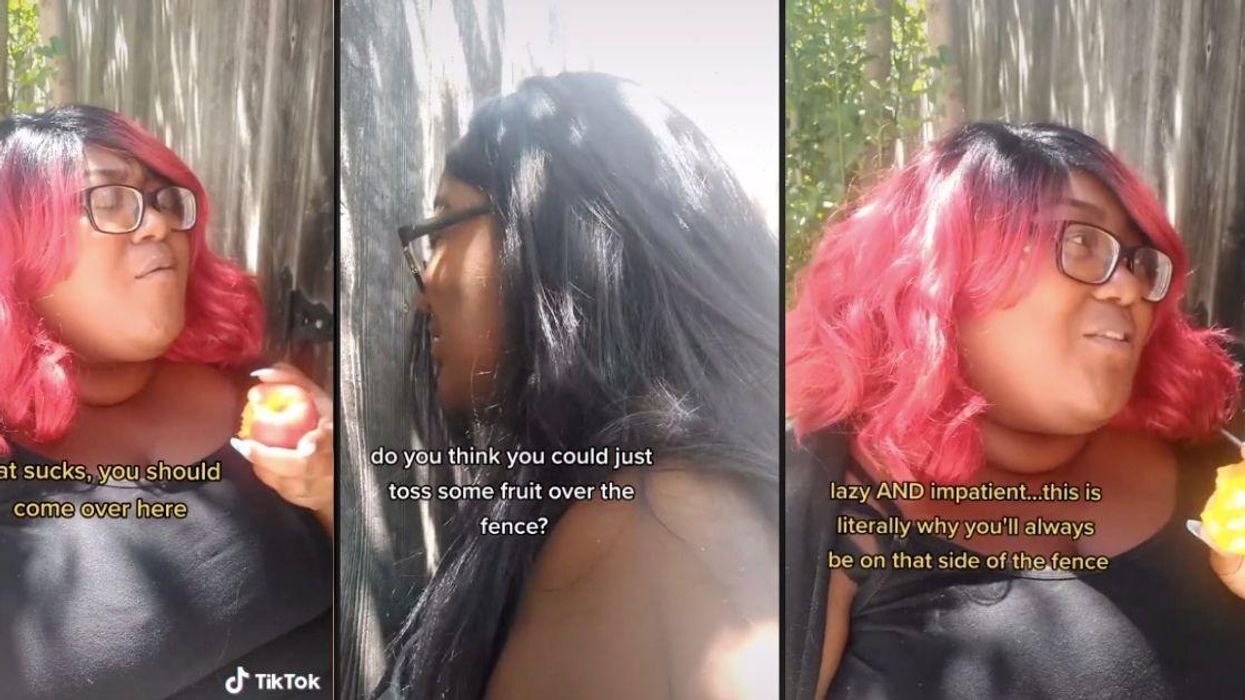
When we talk about systemic, structural, or institutionalized inequality, it can be hard for some to understand what those terms even mean. In a racial context in the U.S., the idea is that oppression like slavery and Jim Crow laws, racist policies like redlining, and the racism in scientific, medical, and educational and other fields erected various barriers for Black Americans. The laws or policies may have changed, but those changes didn’t automatically dismantle all the barriers that went along with them.
Such barriers are invisible, though, and when you aren’t impacted by them you might not even see them at all, or understand what it’s like to be on the other side of them. That’s where analogies come in handy.
TikTok creator @tavitalkstrash shared a video skit that illustrates how systemic inequality works with a metaphor of a fence and fruit trees.
Watch:
@tavitalkstrash The fence #fyp
Many commenters pointed out that the analogy works for all kinds of issues, from racial inequality to wealth or class inequality. Those who have the power and advantage are often blind to the barriers that exist for those who don’t, and even if they do see a barrier, they may actually end up reinforcing it. After all, that barrier isn’t hurting them; in some ways, it actually makes life easier for them.
The video also highlights how bias and prejudice can result from such barriers. “You should just come over here!” As if it’s that simple. “Lazy AND impatient,” as if the challenges posed by the barrier aren’t real.
A person recognizing the barrier and exercising empathy would listen to the person on the other side and try to see their perspective. A person exercising compassion would toss over some fruit and then help tear down the fence.
The tradition of having the fence there wouldn’t matter as much as the harm it’s causing on the other side. The fact that an occasional person manages to get over the fence wouldn’t matter, since the majority aren’t able to. Telling the person to plant their own trees or tear down the fence themselves would be recognized as a cruel response, not a helpful one, considering the lived reality on the other side. The idea of what’s “fair” would take the full reality and history into account.
One key takeaway here is that the person on the fruit tree side needs to listen to the person limited by the barrier when they tell them how it has affected them and what they need to remedy the situation. The solutions offered from the fruit tree side might not make sense from the other side of it. Such solutions might not be possible, or they might not actually be as helpful as they sound.
Another point made in the comments is that the hungry person’s ancestors were probably the ones who planted those fruit trees in the first place. That works whether you look at the metaphor through a historical racial lens (so much of the foundation of this country’s wealth was built on the backs of unpaid, enslaved Black people) or a wealth inequality lens (underpaid working class laborers being exploited by obscenely wealhty business owners in the name of capitalism).
Some might argue that such barriers don’t actually exist anymore, that this is the land of opportunity and equality where we’re all on equal footing. But statistics do not bear that out. As of 2016, the average white family’s net worth was ten times that of the average Black family in the U.S. What is the explanation for that?
If you argue that it is not because structural or systemic racial barriers have made it more difficult for Black Americans to build wealth, then what explanation are you left with? That Black Americans are consciously choosing to live with such a wide economic disparity? Why would they choose that? If they aren’t choosing it, do you think there is some inherent quality that makes Black people unable or unwilling to do whatever it is white people do to build wealth? Isn’t that idea just blatantly racist?
Hopefully, this analogy makes the concept of systemic, structural, and institutionalized inequality easier for people to unpack. Complex social realities aren’t easily simplified, so when someone manages to make a clear visual metaphor, it deserves to be celebrated.
